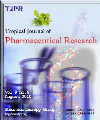
|
Tropical Journal of Pharmaceutical Research
Pharmacotherapy Group, Faculty of Pharmacy, University of Benin, Benin City, Nigeria
ISSN: 1596-5996
EISSN: 1596-5996
Vol. 15, No. 11, 2016, pp. 2435-2443
|
 Bioline Code: pr16321
Bioline Code: pr16321
Full paper language: English
Document type: Research Article
Document available free of charge
|
|
|
Tropical Journal of Pharmaceutical Research, Vol. 15, No. 11, 2016, pp. 2435-2443
| en |
Daidzin decreases blood glucose and lipid in streptozotocin-induced diabetic mice
Tian, Dandan; Liu, Jinjin; Liu, Nan; Wang, Ran; Ai, Yanqiu; Jin, Lifeng; Li, Feng; Wei, Pan; Li, Zefeng; Wang, Chen & Zhang, Wei
Abstract
Purpose: To investigate the ameliorative effect of daidzin (DZ) on diabetes in streptozotocin (STZ)-induced diabetic Institute of Cancer Research (ICR) mice, with a view to determining its usefulness in
the treatment of diabetes.
Methods: The effect of DZ (100, 200 and 400 mg/kg) on blood glucose was investigated in both normal
and STZ-induced diabetic mice with glibenclamide (3 mg/kg) and metformin (400 mg/kg) as positive
control, respectively. Serum or hepatic levels of lipid, proinflammatory factors, malondialdehyde (MDA)
and superoxide dismutase (SOD) were measured. Glucosidase activity assay and glucose uptake by
C2C12 myotubes were performed in vitro and the expression of glucose transporter 4 (GLUT4) in
C2C12 cells was determined by western blot.
Results: DZ (200 and 400 mg/kg) did not decrease fasting blood glucose in normal mice but inhibited
starch-induced postprandial glycemia. Oral administration of 400 mg/kg of DZ for 14 days significantly
decreased mouse blood glucose (p < 0.01), as well as serum total cholesterol (TC, p < 0.01),
triglycerides (TG, p < 0.01), low-density lipoprotein cholesterol (LDL-c, p < 0.01) levels in STZ-induced
hyperglycemic mice and improved oral glucose tolerance. The serum and hepatic activity of SOD was
enhanced (p < 0.01 and p < 0.001, respectively) while MDA level decreased (p < 0.001). Blood
concentrations of interleukin-6 (IL-6, p < 0.001), tumor necrosis factor α (TNF-α, p < 0.01), monocyte
chemotactic protein 1 (MCP-1, p < 0.01) were also significantly reduced. In vitro glucosidase activity
results showed that DZ inhibited α-glucosidase with IC50 values of 82, 98 and 389 μg/mL for α-glucosidase from S. cerevisiae, Rhizopus sp. and rat intestines, respectively. It also stimulated glucose
uptake and GLUT4 membrane translocation in C2C12 myotubes at 20 μM (p < 0.05).
Conclusion: Oral administration of DZ is effective in alleviating diabetic hyperglycemia, dyslipidemia
and inflammation. Inhibition of α-glucosidase and stimulation of glucose consumption by muscles may
account for its inhibitory effect on blood glucose.
Keywords
Daidzin; Diabetes; Inflammation; Superoxide dismutase (SOD); Malondialdehyde (MDA); Glucosidase; C2C12 myotubes; Glucose transporter
|
| |
© Copyright 2016 - Pharmacotherapy Group, Faculty of Pharmacy, University of Benin, Benin City, 300001 Nigeria.
Alternative site location: http://www.tjpr.org
|
|
